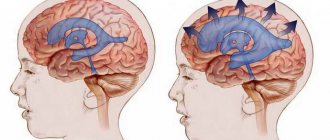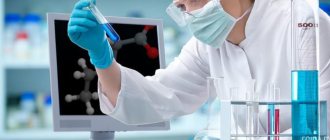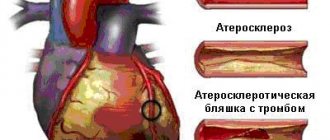Symptoms of hyperlipidemia - how to treat lipid metabolism disorders
Poor diet, sedentary lifestyle, excess weight and genetic predisposition are factors that contribute to the occurrence of hyperlipidemia. Its distinctive feature is increased levels of cholesterol (LDL) or triglycerides (VLDL) or both compounds in the blood serum at the same time. Depending on the concentration of which abnormality, hyperlipidemia is divided into three types: hypercholesterolemia, hypertriglyceridemia and mixed hyperlipidemia.
Dyslipidemia treatment
Modification of dyslipidemia (reduction of total cholesterol, LDL, reduction of triglycerides) is carried out using non-drug and pharmacological methods of influence.
Diets with a sharp decrease in the amount of cholesterol coming from food (foods rich in animal fat, fatty dairy products), with a sufficient amount of polyunsaturated fats, have proven their effectiveness Prevention of physical inactivity and elimination of bad habits also have a positive effect on the lipid spectrum and total cholesterol levels.
As prescribed by a doctor, after examining blood lipids and other indicators (ALT, AST), drugs are used to lower cholesterol levels (statins, cholesterol absorption blockers).
If you follow all the doctor's recommendations for lifestyle modification, diet and regular use of lipid-lowering drugs, such a significant risk factor as dyslipidemia can be significantly modified.
The result of these interventions is proven effectiveness in the prevention and treatment of major significant cardiovascular diseases.
What is hyperlipidemia
In the human body diagnosed with hyperlipidemia, fat metabolism (lipid) is disrupted. For example, increased levels of various fats appear in the blood serum.
LDL cholesterol
LDL is a fatty chemical molecule that is a component of every cell in the body and is involved in the production of hormones and vitamin D. About 2/3 of cholesterol is produced by the liver, but we also take it through food (animal products).
When there is too much of it in the diet, the liver gradually reduces its production, but it cannot completely stop it, so the excess fat must be stored somewhere. First, they are deposited in the skin, then in the form of microscopic clusters they adhere to the walls of blood vessels.
If lipid metabolism is abnormal, there is an increased level of LDL cholesterol or a decrease in the HDL fraction and/or a high concentration of triglycerides (VLDL).
What is dyslipidemia
With this disease, the vascular walls become denser, the gap between them narrows, which causes a disruption in the movement of blood in all organs of the body. This is fraught with the development of ischemic disease of the heart muscle or brain, stroke, heart attack, hypertension. If lipid levels are excessively elevated, the pathology is called hyperlipidemia. The development of the disease is influenced by lifestyle, diet, taking certain medications, lack of activity and bad habits. Dyslipidemia indicates an imbalance of fat elements.
Every day, doctors around the world have to deal with so-called occupational diseases.
Hyperlipidemia - causes and symptoms
One of the most commonly cited causes of hyperlipidemia is poor diet. The level of bad cholesterol is affected primarily by eating large amounts of animal products, as well as overeating.
Hyperlipidemia is promoted by significant excess weight, which often results in increased levels of LDL cholesterol in the blood . Losing extra pounds can be very important in the fight against hyperlipidemia.
It should be noted that there are two types of cholesterol in the human body:
HDL, that is, high-density lipoproteins , is responsible for transporting cholesterol to the liver, its action is beneficial for the body
LDL, that is, low-density lipoproteins , is a carrier of cholesterol for extrahepatic cells. Plays a major role in the formation of atherosclerotic plaques. The higher its level in the blood, the higher the risk of cardiovascular disease.
Low physical activity and a sedentary lifestyle, combined with poor eating habits , contribute to increased levels of bad cholesterol in the blood. Age may also play a role in the development of hyperlipidemia. This disease most often affects older people (lipid levels increase with age in both women and men); it occurs very rarely in children.
Hyperlipidemia can be hereditary. It manifests itself as an increased concentration of lipids in the blood, which causes atherosclerosis and other complications associated with it. Congenital hyperlipidemia manifests itself at a young age, and its treatment is based on pharmacological therapy.
There are no specific symptoms of hyperlipidemia .
They appear when it causes disturbances in the functioning of the cardiovascular system, for example, atherosclerotic changes. The only symptom is yellowish nodules that appear on the eyelids, knees, elbows and Achilles tendon.
Reasons for the development of pathology
Dyslipidemia is not necessarily associated with lifestyle, although nutritional factors and bad habits play a significant role in its development. There are many other reasons, some of which simply cannot be eliminated. For example, a violation of the lipoprotein ratio associated with a certain gene disorder. In this case, dyslipidemia is transmitted to children from parents and manifests itself as atherosclerosis at a young age.
This is interesting: Panavir gel: instructions and recommendations for use against herpes, papillomas and warts, review of analogues and reviews
A predisposition to lipid imbalance may also be hereditary, affecting all related family members. This is familial hyperlipidemia associated with increased lipid synthesis by liver cells. When combined with other atherogenic factors, it also leads to the development of atherosclerosis.
The nutritional cause of lipid metabolism disorders is indiscriminate eating , namely uncontrolled consumption of fatty foods of animal origin. At first, the imbalance is transient: dyslipidemia lasts for 24 hours after a culinary error, and then the level of lipoproteins levels out. Over time, enzyme systems are depleted and, regardless of the frequency of eating unhealthy foods, dyslipidemia is permanent.
There are several more atherogenic factors that people are capable of, but do not want to exclude from their lives:
- smoking;
- drinking alcohol;
- reduced motor activity.
People can minimize the impact of other causes of dyslipidemia caused by chronic diseases with metabolic disorders. Timely and adequate treatment of diabetes mellitus, cholelithiasis, obesity, correction of hormonal levels in hypo- and hyperthyroidism can act as preventive measures to prevent hyperlipoproteinemia.
Hyperlipidemia - treatment and diet
Treatment of hyperlipidemia is, first of all, a radical change in eating habits, adherence to a proper diet and the beginning of physical activity.
Overweight and obese people need to get rid of extra pounds. The most important dietary recommendations include reducing the consumption of foods high in fat and cholesterol (fatty dairy and meat products, organ meats and egg yolks), increasing the consumption of fiber, vegetables, fruits and fish, and avoiding processed fats (baking and frying should be used instead of frying). steam cooking). In addition, you should eat 4-5 meals a day and not snack in between.
Don't forget to have breakfast, and give up a late and hearty dinner. If dietary changes are not enough, drug therapy must be introduced. Hyperlipidemia, especially mixed, often leads to coronary heart disease or heart attack.
The prognosis of DL depends on the form and severity of the syndrome, the degree of development of atherosclerosis and the presence of atherosclerosis-related diseases.
Prevention of DL is based on behavioral measures.
A balanced diet can reduce LDL by only up to 20%, but the effect of diet on TG and VLDL is noted. In addition, a healthy diet is a significant factor in reducing overall mortality.
The amount of calories consumed from food should help maintain normal body weight. In this regard, it is recommended to limit the consumption of animal fats (no more than 10%), and the total amount of fat should not exceed 20-30% of the total daily caloric intake. The daily intake of cholesterol from food should not exceed 300 mg in persons without DL and atherosclerosis, and in the presence of these conditions - no more than 200 mg.
It is important to reduce your intake of saturated fat and not overemphasize the importance of limiting certain fatty foods, such as eggs, as they are a valuable source of many nutrients. Particularly atherogenic saturated fats are trans fats found in hard margarines and processed foods.[9][13]
Fruits and vegetables (not counting potatoes) should be consumed at least 400-500 g per day. The consumption of meat products, offal and red meat should be limited. It is better to eat more other protein foods: legumes, fish or poultry. Every day you need to consume dairy products low in fat and salt (kefir, sour milk, cheese, yogurt).
Simple sugars are needed in daily food, but their share should not exceed 10% of the total calorie intake. The total amount of salt consumed, including salt contained in prepared foods, should not exceed 5 g per day, this is especially important for people with arterial hypertension.
It is useful to eat deep-sea fish from the northern seas (selfish, sardines, mackerel, salmon) at least 2-3 times a week. This is due to the high content of ω-3 PUFAs in these varieties, which help prevent atherosclerosis. Plant sterols/stanols are found in plant seeds, nuts and vegetable oils. In doses of about 2 g per day, they do not allow cholesterol to be absorbed in the intestine.[2][4]
Reducing excess weight is a prerequisite for the prevention of DL and cardiovascular complications. Reducing body weight is achieved by prescribing a low-calorie diet and regular adequate physical activity. For anthropometric assessment, the body mass index (BMI) = weight in kg/height m2 should be used. Normal BMI is 18.5-25 kg/m2. Waist circumference (WC) is measured to assess the type of obesity. The normal WC in men is no more than 94 cm, in women – no more than 80 cm. WC over 102 cm in men and 88 cm in women is an indicator of abdominal obesity, which is associated with an increased risk of cardiovascular complications.[15]
All patients with DL, excess body weight and other risk factors are recommended to increase daily physical activity, taking into account age, fitness and existing diseases. The most physiological, safe and accessible aerobic physical exercise for everyone is walking. It is recommended to do it 5-6 times a week for at least 30-45 minutes, achieving a heart rate of 60-75% of the maximum for a person. The maximum heart rate is calculated using the formula: 220 – age (years). People with coronary artery disease and other diseases of the cardiovascular system should develop an individual training regimen, taking into account the performance of a stress test (bicycle ergometer or treadmill).[2][3]
Physical training is an important component of the prevention of DL. They reduce heart rate and blood pressure, allow adaptation to ischemic conditions, stabilize hormonal levels and tissue oxygenation. Aerobic, dynamic, cyclic loads of adequate intensity are more effective - walking, hiking, swimming, skiing and cycling.
It is important to quit smoking in any form, including passive smoking. The smoking cessation program algorithm consists of several principles:
- identification of smokers;
- assessment of the severity of the habit and readiness to get rid of it;
- an explanation of the dangers of smoking and a recommendation to quit it;
- if necessary, medical assistance, including complex therapy;
- Regular monitoring of a smoking patient by a doctor.
The most effective medication for quitting smoking is varenicline (Champix). It is a blocker of nicotinic receptors in the brain, as a result of which the craving for smoking is suppressed, the pleasure from the process is reduced and withdrawal symptoms are reduced.
A number of studies have shown that moderate alcohol consumption can have a positive effect on DL. Drinking no more than 150 ml of alcohol per week for men and 100 ml for women is considered safe for health, subject to daily consumption of no more than 20 g for men and 15 g for women. However, any doses of alcohol are not recommended for people with arterial hypertension, hypertriglyceridemia, diseases of the hepato-biliary and pancreatic zone, gout and obesity. Alcohol abuse during statin therapy can lead to myopathy and rhabdomyolysis.[6]
Preventive statin therapy is also an effective way to prevent DL. For this purpose, low doses of modern statins are often used:
- simvastatin 10-20 mg per day;
- atorvastatin 10-20 mg per day;
- rosuvastatin 5-10 mg per day;
- pitavastatin 1-2 mg per day.
Symptoms of dyslipidemia
Since DL is a laboratory syndrome, its manifestations are associated with atherosclerosis of the arteries of the organs and tissues that they supply:
- cerebral ischemia;
- cardiac ischemia;
- obliterating atherosclerosis of the arteries of the lower extremities, etc.
Coronary heart disease is the most common and dangerous atherosclerosis-dependent disease. It kills more people than all types of cancer. Most often, this disease manifests itself in the form of angina pectoris or myocardial infarction.
Angina pectoris was previously called “angina pectoris”, which accurately characterizes the symptoms of the disease - pressing or squeezing sensations behind the sternum at the height of physical or emotional stress, lasting several minutes and stopping after interrupting the load or taking nitroglycerin.
Myocardial infarction is associated with the rupture of an atherosclerotic plaque in a cardiac artery and the formation of a blood clot on the plaque. This leads to rapid closure of the artery, acute ischemia, myocardial damage and necrosis.
The brain can suffer from chronic and acute ischemia, which is manifested by dizziness, loss of consciousness, loss of speech and motor function. This is nothing more than a cerebral stroke or a pre-stroke condition - a transient ischemic attack. With obliterating atherosclerosis of the lower extremities, the blood supply to the legs decreases. It is worth noting that atherosclerosis remains asymptomatic for a long time; clinical manifestations begin when the artery narrows by 60-75%.
Familial genetic dyslipidemias can manifest as stigmata, such as skin xanthomas and eyelid xanthelasmas.
A significant increase in the concentration of blood triglycerides (more than 8 mmol/l) can lead to acute pancreatitis, which is accompanied by severe pain in the upper abdomen, nausea, vomiting, rapid heartbeat and general weakness.
What is dyslipidemia and what to do if the disease is detected?
Dyslipidemia is a common pathological condition found in people of different genders and ages. Against this background, other diseases develop, the patient’s health deteriorates sharply, and oxygen starvation of the brain may occur. Dyslipidemia in most cases responds well to therapy, but combating the disease requires not only the use of a set of medications, but also a review of lifestyle. In addition, you need to visit a doctor on time, who will prescribe mandatory diagnostic measures and tell you about the features of treating the disease in a particular case. Dyslipidemia, hyperlipidemia or hyperlipoproteinemia is a disorder of lipid balance in the blood. It is the main provoking factor in the appearance of atherosclerosis, a chronic disease characterized by thickening of the walls of blood vessels and the formation of sclerotic plaques in them. Dyslipidemia is accompanied by a rapid increase in lipid complexes in the bloodstream and a violation of their excretion from the body.
Analysis of the medical history and complaints - when (how long ago) xanthomas (dense nodules containing cholesterol above the surface of the tendons), xanthelasmas (cholesterol deposits under the skin of the eyelids in the form of nodules) appeared.
Pathogenesis of dyslipidemia
The main lipids in blood plasma are:
- cholesterol (CH) is a precursor of bile acids, sex hormones and vitamin D;
- phospholipids (PL) are the main structural components of all cell membranes and the outer layer of lipoprotein particles;
- triglycerides (TG) are lipids formed from fatty acids and glycerol that enter the body with food, then transported to fat depots or included in lipoproteins.
Fatty acids (FA) in blood plasma are a source of energy and a structural element of TG and PL. They are saturated and unsaturated. Saturated fatty acids are part of animal fats. Unsaturated fatty acids make up vegetable fats and are divided into mono- and polyunsaturated fatty acids. Monounsaturated fatty acids are found in large quantities in olive oil, and polyunsaturated fatty acids are found in fish oil and other vegetable oils. It is believed that all these fats are necessary for humans; their balanced amount should be up to 30% of the daily caloric intake of food and distributed approximately into three equal parts between mono-, polyunsaturated and saturated fatty acids.
The combination of fats and proteins is called lipoproteins or lipoproteins.
What are lipids, lipoproteins and hyperlipidemia?
There is an opinion that fats are harmful to the body. It's not like that at all. Fats are the most important component of all living organisms, without which life is impossible. They are the main “energy station”; through chemical reactions they produce the energy necessary for metabolism and cell renewal.
Fats become harmful when their content is excessive, especially certain types that lead to atherosclerosis and other diseases - low-density lipids, or atherogenic ones. All fatty substances in the body are divided into 2 groups according to their chemical composition:
The name comes from the Greek lipos - fat. This is a whole group of fat-forming substances in the body, including:
- fatty acids (saturated, monounsaturated, polyunsaturated);
- triglycerides;
- phospholipids;
- cholesterol.
The fatty acids that everyone knows about and which play a big role in the development of atherosclerosis are saturated ones. They are found in animal products. Unsaturated acids, on the contrary, prevent the development of atherosclerosis; they are found in vegetable oils and seafood (omega 3, omega 6, omega 9 and others).
Triglycerides are neutral fats, derivatives of glycerol, which are the main suppliers of energy. Their increased content contributes to the development of diseases. Phospholipids contain a phosphoric acid residue and are necessary for the maintenance of nervous tissue.
Finally, everyone knows cholesterol - the main culprit of many diseases, and the most common “disease of the century” - atherosclerosis. It comes in two types: high density, or “good cholesterol,” and low density, or “bad cholesterol.” It is this substance that is deposited in organs, causing fatty degeneration, in blood vessels, causing circulatory problems.
Lipoproteins
These are more complex compounds, including lipids and protein molecules. They are divided into:
- chylomicrons, which perform a transport function, deliver fat from the intestines to tissues and organs, including promoting its deposition in the subcutaneous tissue;
- lipoproteins of various densities - high (HDL), low (LDL), intermediate (LDL) and very low (LDL).
Lipoproteins and low-density lipids, chylomicrons contribute to the accumulation of fatty substances and “bad” cholesterol in the body, that is, the development of hyperlipidemia, against which diseases develop.
Hyperlipidemia: diagnosis and treatment
The problem of hyperlipidemia is relevant and often appears at a young age. Women should think about checking their cholesterol at 35-40 years old, and men are recommended to check their lipids even earlier.
High cholesterol can be hereditary or acquired.
Find out from your family if this problem exists in your family. Acquired hyperlipidemia is the result of an unhealthy lifestyle. Often this problem develops in childhood due to poor nutrition. A person gets used to harmful products, and in adulthood cannot refuse them.
Lipid fractions and dyslipidemia
A person learns about dyslipidemia by receiving the result of a blood test. In most cases, the patient does not even suspect what it is, since the pathological condition does not manifest itself in any way.
The human body needs fats and fat-like substances to function properly. One of them is cholesterol. The main share of this compound is formed in the liver and only a fifth comes from food. Cholesterol is necessary for all cells. It participates in the construction of membranes, but cannot enter the tissues with the bloodstream because it is insoluble in plasma. To deliver cholesterol to cells, carrier proteins are needed. When they combine with a lipid, they form lipoprotein complexes of the following types:
- VLDL (very low density);
- LDL (low density);
- DIPP (intermediate density);
- HDL (high density).
The lower the density of the lipoprotein, the easier it breaks down, releasing cholesterol. VLDL and LDL deliver lipid from the liver to the cells, and the higher the concentration of these fractions, the correspondingly higher the likelihood of “losing” cholesterol “along the way.” It, in turn, settles on the walls of blood vessels, limiting blood flow and forming an atherosclerotic plaque.
HDL is more stable. They provide reverse transport of cholesterol to the liver, where it is formed into bile. All excess of this lipid should normally be eliminated, but this does not always happen. When low-density lipoproteins increase in the blood and the concentration of HDL decreases, this is one of the signs of dyslipidemia.
Doctors operate with such an indicator as the atherogenic coefficient. This is the ratio of total cholesterol to HDL content reduced by one. If the atherogenic index value is more than 3, then we speak of dyslipidemia.
In addition, this pathological condition is accompanied by excessive plasma concentrations of triglycerides and chylomicrons. The former are esters of glycerol and fatty acids. By splitting, they provide cells with energy - this is one of their most important functions. An increase in the concentration of triglycerides (TG) in the blood plasma is another sign of dyslipidemia. Like cholesterol, these compounds “travel” throughout the body in combination with proteins. But an excess of free TG is fraught with a high risk of atherosclerosis.
However, increased concentrations of another transport form, chylomicrons, are also observed in some forms of dyslipidemia.
Types of hyperlipidemia
The classification of hyperlipidemia is based on LDL, HDL, and triglycerides. The concentration of lipoproteins is measured:
Low density – LDL, VLDL, TG;
- High density HDL.
It is cholesterol that has a low density that is considered “bad”. It forms plaques and creates a risk of developing vascular pathology. It is important for the doctor to achieve a reduction in LDL cholesterol. However, total cholesterol levels may remain slightly elevated.
In total, there are 6 types of hyperlipedemia. Three of them are considered dangerous: 2a, 2b and 3. They are dangerous because they threaten the formation of dense plaques.
Type 2 is considered common. It is divided into 2a and 2b. With 2a, an increase in LPN and total cholesterol is observed. 2b – all factions are increased.
*Note: 4 and 5 can also be atherogenic with low HDL and other metabolic disorders.
Classification of the disease
Based on the amount of lipids, the following types of pathology are distinguished:
- Isolated hypercholesterolemia, when cholesterol, which is part of lipoproteins, is increased.
- Mixed hyperlipidemia, when the analysis reveals an increase in cholesterol and triglycerides.
According to the mechanism of occurrence, dyslipidemia can be primary (this includes hereditary pathologies) or secondary, which appears under the influence of unfavorable factors.
In addition, there is a Fredrickson classification, in which the types of disease depend on the type of lipid that is elevated. In most cases, the disease can lead to atherosclerosis. The following forms are distinguished:
- Hereditary hyperchylomicronemia. It differs in that only chylomicrons are elevated in the blood test. This is the only subtype in which the risk of developing atherosclerosis is minimal.
- Type 2a is hereditary hypercholesterolemia or caused by unfavorable external factors. At the same time, LDL levels are increased.
- Type 2b, this includes combined hyperlipidemia, when very low and low density lipoproteins, as well as triglycerides, increase.
- The third type includes hereditary dys-beta-lipoproteinemia, when LDL is elevated.
- Type 4 is called endogenous hyperlipidemia, with increased levels of very low-density lipoproteins.
- The last 5 types include hereditary hypertriglyceridemia, in which chylomicrons and very low-density lipoproteins are increased.
Diagnosis of the disease
To clarify the risk of developing atherosclerosis, the doctor prescribes a lipid profile test. This is a comprehensive study of the content of cholesterol and its metabolites in the blood. The analysis helps to establish the type and select therapy. Blood is taken on an empty stomach, from a vein.
Ø total cholesterol;
Ø low, very low and high density lipoproteins;
Based on their ratio, the risk of developing cardiovascular diseases and the probability of coronary heart disease are calculated.
A normal value would be from 3 to 5.1 mmol. The most common indicator is 6, 7 or even 8. This level of cholesterol is considered dangerous. If the threshold values are exceeded, this means that the plaque formation process has started.
When an increase in VLDL levels is observed along with total cholesterol, the result indicates an increased risk. Determination of lipid levels is also required to monitor therapy. The high level should gradually decrease.
Symptoms of the disease
In the initial stages, dyslipidemia is determined only in the laboratory by performing a specific blood test - a lipid profile. It includes indicators such as high, low, and very low density lipoproteins, triglycerides and total cholesterol contained in all of them. An isolated increase in the level of any one substance is very rare. Mixed hyperlipidemia usually develops.
This is interesting: The importance of testosterone for men
Over time, excess lipoproteins begin to be deposited not only in the vascular walls, but also in other tissues. So, during examination, the doctor may notice cholesterol deposits on the cornea of the eyes and on the surface of the skin.
- Along the edge of the cornea, grayish-yellow stripes are observed, curved in the form of a semicircle (lipoid arc).
- In different areas of the skin, deposits are yellowish tubercles, plaques, flat spots, clearly defined and painless. They are called xanthomas, and when localized in the upper eyelid - xanthelasmas.
External manifestations of obvious dyslipidemia
Based on the examination, the doctor cannot determine the true nature of the disorders occurring in the blood, and so far the hyperlipidemia is unspecified. To prescribe a correction, a full range of diagnostic measures are carried out.
Treatment and prevention
Therapy begins with a diet; if it is ineffective, medications - statins - are prescribed.
Therapy makes sense only if you take medications regularly. You need to monitor your cholesterol levels and lipid profile at least once a quarter. Along with the analysis, monitoring of liver function is prescribed, for this they give: ALT, GGTP, AST, total bilirubin. A significant increase in ALT AST speaks in favor of discontinuing treatment or consulting a hepatologist.
In addition to classical medicines, complementary and alternative medicines are used. Cholesterol absorption blockers are used. They are effective only when bad cholesterol is supplied externally.
Medicines: This is the most reliable way to lower cholesterol
Another type of drug is fibrates. They were developed to treat hypercholesterolemia, but are used less frequently due to significant side effects.
Prevention
Practical tips for lowering cholesterol:
Try to eat enough vegetables and fruits;
Make sure your nutrition is complete;
Avoid daily consumption of meat and dairy products.
The diet involves consuming meat no more than 2 - 3 times a week, preferably even less often.
Introduce sea or river fish into your diet. It is better if it is boiled or baked fish dishes.
Drink enough fluids, eat more vegetables and fruits.
Use all the possibilities of exercise therapy and try to lead an active lifestyle.
If you suspect hyperlipidemia, consult your doctor. He will conduct a thorough diagnosis and select a course of therapy.
1. Drobot E.V., Alekseenko S.N., “Prevention of diseases.”
2. Journal Difficult Patient “Prediabetes: diagnosis and treatment.”
3. Litvitsky P.F. “Algorithms for educational modules on clinical pathophysiology.”
4. Kumar V., Abbas A.K., Fausto N., Aster J.K. “Fundamentals of disease pathology according to Robbins and Cotran.”
Main causes of dyslipidemia
Dietary excess intake of large amounts of animal fats and excess cholesterol. This cause of dyslipidemia is the leading and most significant.
Other possible causes of dyslipidemia:
- Endocrine diseases (diabetes mellitus, Itsenko-Cushing syndrome, polycystic ovarian disease, decrease in thyroid hormones in the blood (hypothyroidism).
- During pregnancy (especially in later stages), transient dyslipidemia may occur.
- Hereditary hypercholesterolemia, which is a manifestation of many genetic abnormalities. Currently, a number of diseases are diagnosed, manifested by various changes in the lipid spectrum.
- Excessive consumption of alcohol and drinks containing it (more than 2 drinks in men and 1 drink in women) on a regular basis. For one dose of alcohol, 10 ml of ethanol is taken.
- Kidney diseases with decreased filtration function of nephrons, accompanied by CKD.
- Chronic liver diseases, one of the symptoms of which is stagnation of bile - cholestasis.
- Blood diseases - myeloma and other syndromes combined with an increase in immunoglobulin proteins.
- Systemic diseases with connective tissue damage (scleroderma, RA, lupus erythematosus).
- Taking certain pharmacological drugs - from the group of diuretics, β-blockers and others.
- A disorder of purine metabolism, manifested by excessive concentrations of uric acid in the plasma (hyperuricemia, gout, gouty nephropathy).
The causes of dyslipidemia are divided into congenital and acquired.
Among the main factors that contribute to an increase in the level of cholesterol complexes in the blood are the following:
- Hereditary predisposition. This reason in most cases provokes primary dyslipidemia.
- The presence of a disease that is accompanied by an increase in fat concentration. These include diabetes mellitus, thyroid problems, and atherosclerosis. They cause secondary dyslipidemias - those that appear as a result of a disruption in the functioning of another organ.
- Unhealthy Lifestyle. Physical inactivity, smoking, and poor nutrition increase the level of cholesterol and triglycerides in the blood, which causes secondary dyslipidemia.
- Frequent consumption of animal fats can cause dyslipidemia, which is called nutritional dyslipidemia.
If the cause has not been identified, it is unspecified dyslipidemia.
The list of conditions under which the concentration of fats in the blood may increase:
- obesity;
- autoimmune disorders;
- diabetes;
- nephrotic syndrome;
- use of certain medications.
People at risk for developing dyslipidemia include:
- hypertension;
- obesity;
- endocrine diseases;
- wrong lifestyle;
- predisposition by gender and age.
Hyperlipoproteinemia occurs for reasons that are divided into two groups:
- causing the development of diseases;
- contributing to its progression.
Some etiological factors can be eliminated (modifiable), others remain with a person for life (non-modifiable).
Bad habits can lead to illness
The reasons that can lead to this state of the body are conditionally divided into three main groups.
The first includes hereditary predisposition to the disease; this factor concerns the primary types of dyslipidemia.
The second group of reasons (it concerns secondary types) includes external dangerous factors and some diseases:
- diabetes;
- disruption of metabolic processes in the body;
- liver diseases (gallbladder stones and others);
- taking immunosuppressants;
- alcohol abuse, smoking, drug addiction;
- long-term use of medications (for example, beta-blockers);
- psycho-emotional stress.
Atherogenic dyslipidemia can also develop against the background of excessive consumption of large amounts of cholesterol in food (lard, fatty meats, use of animal fats for cooking).
Carefully! Doctors identify a sedentary lifestyle among the factors leading to the disease.
Hyperlipidemia
Hyperlipidemia (hyperlipoproteinemia, dyslipidemia) is an excessively high level of fats (lipids and/or lipoproteins) in human blood.
The content of lipoproteins, especially LDL cholesterol, increases with age. Normally, it is higher in men, but in women after menopause (menopause) it begins to increase.
Hyperlipidemia is an important risk factor for cardiovascular disease, mainly due to the significant influence of cholesterol on the development of atherosclerosis . In addition, some hyperlipidemias affect the development of acute pancreatitis .
Definition of disease. Causes of the disease
Dyslipidemia (DL) is a pathological syndrome associated with impaired lipid and lipoprotein metabolism, i.e. changing the ratio of their concentrations in the blood. [1] It is one of the main risk factors for atherosclerosis-related diseases.
Lipids and lipoproteins are one of the sources of energy needed by the human body. They are fat-like organic compounds. Lipids are part of lipoproteins.
The causes leading to the development of dyslipidemia can be divided into unchangeable (endogenous) and changeable (exogenous).
Causes of hyperlipidemia
Other factors that contribute to the high content of some lipids (for example, VLDL and LDL):
Most often, the increase in triglyceride levels and total cholesterol is temporary and mild, mainly as a result of an increase in dietary fat intake. Different people's bodies remove fats from the blood at different rates. One person may eat large amounts of animal fat and never have total cholesterol levels rise above 4 mmol/L, while another eats a strict no-fat diet and never reaches total cholesterol levels below 6 mmol/L. This difference is likely due in part to heredity and is largely determined by differences in the rate at which lipoproteins enter and are removed from the bloodstream.
Dyslipidemia is
Lipemia is the content of fatty substances lipids in the blood, hyperlipemia is their increased content. Physiological hyperlipemia occurs after eating, especially after food rich in fat, lasts for 8-10 hours, and during pregnancy. Pathological hyperlipemia is observed in certain diseases of the liver and kidneys, diabetes, anemia, fasting, hypothyroidism, as well as in case of poisoning with chloroform, alcohol, and phosphorus. Lipemia from Greek. Under physiological conditions, lipemia occurs within 3-4 hours after eating a meal rich in fat; reaches a maximum after 6 hours, after which the fat content returns to its original level. Lipemia is observed with changes in the functional state of the body: pregnancy, fasting; may be the result of delayed removal of lipids from the bloodstream, disruption of the normal rate of lipid synthesis and breakdown. Lipemia also occurs in various pathological conditions of the body - with diabetes, obstructive jaundice, nephrosis, pancreatitis, hypothyroidism, xanthomatosis and atherosclerosis; for bloodletting and bleeding, for severe anemia caused by poisoning with various substances: benzene, chloroform, pyridine, phenylhydrazine, phosphorus; with chronic alcoholism. With severe lipemia, blood plasma acquires a milky white, cloudy color.
Diagnostics
Blood can be taken for a test that measures total cholesterol levels at any time. However, to measure HDL cholesterol, LDL cholesterol and triglycerides, blood tests are best done after at least 12 hours of fasting.
List of diagnostic methods:
- blood biochemistry,
- high density lipoproteins (HDL),
- low density lipoproteins (LDL),
- OLDL (oxidized low-density lipoprotein),
- antibodies to OLDL.
Types of dyslipidemias
Dyslipidemias are divided into congenital and acquired, as well as isolated and combined. Hereditary dyslipidemias are monogenic, homozygous and heterozygous. Acquired can be primary, secondary or alimentary.
Dyslipidemia is essentially a laboratory indicator that can only be determined by the results of a biochemical blood test.
According to the Fredrickson classification of dyslipidemias (hyperlipidemias), which is adopted by the World Health Organization as the international standard nomenclature for lipid metabolism disorders, the pathological process is divided into five types:
- dyslipidemia type 1 (hereditary hyperchylomicronemia, primary hyperlipoproteinemia) – characterized by an increase in the level of chylomicrons; does not relate to the main causes of the development of atherosclerotic lesions; frequency of occurrence in the general population – 0.1%;
- dyslipidemia type 2a (polygenic hypercholesterolemia, hereditary hypercholesterolemia) – increased levels of low-density lipoproteins; frequency of occurrence – 0.4%;
- dyslipidemia type 2b (combined hyperlipidemia) – increased levels of low-density lipoproteins, very low-density lipoproteins and triglycerides; diagnosed in approximately 10%;
- dyslipidemia type 3 (hereditary dys-beta-lipoproteinemia) – increased levels of intermediate-density lipoproteins; high probability of developing atherosclerotic lesions of blood vessels; frequency of occurrence – 0.02%;
- dyslipidemia type 4 (endogenous hyperlipemia) – increased levels of very low density lipoproteins; occurs in 1%;
- dyslipidemia type 5 (hereditary hypertriglyceridemia) - increased levels of chylomicrons and very low density lipoproteins.
Causes
Hyperlipidemia is a consequence of the lifestyle a person leads, what they eat, and what medications they take. Lifestyle here includes physical activity, weight (obesity), smoking. Also, in the presence of diabetes mellitus, decreased thyroid function, and pregnancy, hyperlipidemia develops more actively. This disease can also be hereditary in nature with normal weight and a healthy lifestyle. The risk group includes people over 45 years of age (men) and 55 years of age (women). Thus, you can make a certain forecast: if your male relative (brother or father, younger than 45 years old) suffers from hyperlipidemia, or your mother or sister (younger than 55 years old) suffers from this disease, then you have a high risk of having a hereditary form of heart disease, including hyperlipidemia.
Causes
It is impossible to clearly name the reasons for this violation. At the same time, depending on the development mechanism, experts talk about the primary, secondary and nutritional forms of the pathological condition. Primary is also called hereditary, and it is associated with gene mutations, so its causes are defects that can be contained in the genes of one or both parents and are transmitted hereditarily.
Secondary occurs as a consequence of pathological conditions of various organs and systems of the body. In particular, the causes of this form of disorder are: diabetes mellitus, hypothyroidism, chronic renal failure, liver disease.
Nutritional dyslipidemia develops when a person eats too much fat. In addition, they talk about this form if it developed while taking certain medications. The reasons may lie in the presence of predisposing factors in a person, such as:
- bad habits;
- poor nutrition;
- abdominal obesity;
- age above 50 years.
People with a family history, that is, those who have or have had coronary heart disease or a heart attack in their family, have a higher risk of developing a disorder such as hyperlipidemia than people whose relatives have never suffered from heart pathologies. -vascular system.
Treatment of hyperlipidemia
Treatment of the disease is based on blood lipid levels, the risk of developing heart disease and the general condition of the body.
The first step in the treatment of primary hyperlipidemia is the correction of diet. In all patients with mild or moderate hyperlipidemia, weight should be initially normalized and then maintained with an appropriate diet that is particularly low in saturated fat and cholesterol. If hypertriglyceridemia is detected in a patient, alcohol consumption should be limited or completely eliminated.
At the very beginning of treatment, the doctor will recommend introducing changes to your established lifestyle:
- diet (do not eat fatty foods),
- sports,
- normalization of blood pressure,
- clear cessation of smoking.
Drug treatment
If the above set of measures does not help reduce lipid levels, or according to various indicators there is a risk of atherosclerosis, then drug treatment is prescribed. Typically, medications are used to treat men over 35 years of age and women during menopause.
The following medications are commonly prescribed to reduce lipid levels:
- statins (they prevent the formation of cholesterol in the liver),
- fibrates,
- vitamin B5 (niacin),
- medications that bind bile acid.
Treatment
Treatment of dyslipidemia depends on the type, severity and type of dyslipidemia and is selected individually for each patient. There are several types of treatment for dyslipidemia:
- drug treatment;
- non-drug treatment;
- diet therapy;
- extracorporeal therapy;
- genetic engineering methods.
All treatment methods are aimed at normalizing lipid metabolism, reducing cholesterol and lipoprotein levels.
Drug treatment:
- Statins are drugs whose action is aimed at reducing the synthesis of cholesterol by hepatocytes and its intracellular content;
- Cholesterol adsorption inhibitors are a group of drugs that interfere with the intestinal absorption of cholesterol;
- Ion exchange resins (bile acid sequestrants) are a group of pharmaceuticals that have the ability to bind bile acids and the cholesterol they contain and remove them from the intestinal lumen;
- Fibrates are drugs that lower triglyceride levels in the blood and increase the amount of protective substances HDL;
- Omega-3 polyunsaturated fatty acids are preparations synthesized from fish muscle that protect the heart from heart attack and reduce the risk of developing arrhythmias.
The effect of statins on cholesterol
Non-drug treatment
It is not advisable to treat dyslipidemia with medications without using non-drug methods. After all, by adjusting your diet, work and rest schedule, as well as physical activity, you can achieve a very good therapeutic effect. To do this you need:
- reduce the amount of animal fats in the daily diet, and sometimes completely abandon them;
- normalize body weight;
- increase physical activity corresponding to the patient’s strengths and capabilities;
- switch to a balanced, fortified and fractional diet;
- sharply limit or completely stop drinking alcohol, which increases the amount of triglycerides in the patient’s blood, contributes to the thickening of the walls of blood vessels and accelerates the development of atherosclerosis.
- Smoking also plays an important role in the development of this disease.
Diet therapy
As mentioned above, diet for dyslipidemia is one of the main factors in effective treatment. Diet is not a temporary phenomenon, but a way of life and nutrition on which the prevention of atherosclerosis is based. The diet for this disease is aimed at reducing cholesterol levels in the patient’s blood and has several principles:
- limit the consumption of fatty meats, fish, lard, shrimp, butter, fatty dairy products, industrial cheeses, sausages and frankfurters;
- enrich your diet with fats of plant origin, vegetables, fruits, lean poultry and fish;
- low-fat fermented milk products are also indicated for this type of disease;
- It is recommended to eat meals in small portions at regular intervals.
Extracorporeal treatment
This treatment is used to change the properties and composition of blood outside the human body. Severe atherogenic dyslipidemia is an indication for the use of this method. After all, atherogenic dyslipidemia is a factor contributing to the development of complications in the form of cardiovascular diseases.
Genetic engineering methods
This type of treatment in the future may become one of the main ones in the treatment of hereditary dyslipidemia. The developments of genetic engineering are used to change genetic material and give it the desired qualities. This type of treatment is being developed for the future.
Development of atherogenic dyslipidemia
Atherogenic dyslipidemia is registered if the balance between LDL and HDL is disturbed, that is, the level of cholesterol increases and “good” cholesterol decreases. This is quantitatively expressed by an increase in the atherogenic index to 3 units or more.
Additional risk factors include lifestyle features:
- physical inactivity;
- regular alcohol consumption;
- smoking;
- stress;
- love for fast food.
All of the above points can trigger pathological changes encoded genetically, or aggravate the course of an already developed condition. Against the background of these factors, astheno-vegetative syndrome is formed. It manifests itself in disorders of the autonomic nervous system that can negatively affect any organ.
Often asthenovegetative disorders develop with hypertension, diabetes mellitus, and atherosclerosis. And in such cases, it is extremely difficult to figure out what exactly was the trigger.
Dyslipidemia in children
Lipid metabolism disorders are recorded not only in adults. Children and adolescents are susceptible to them. Most often their dyslipidemias are primary, that is, hereditary. In 42% of cases, form 2b is diagnosed. At the same time, by the age of five, the child develops xanthomas, signs of heart damage and vegetative-asthenic disorders.
Secondary dyslipidemia in children is most often observed in pathologies of the gastrointestinal tract. Diseases of the duodenum and stomach, diseases of the liver and pancreas can disrupt the balance of lipids in the child's body. A decrease in the formation of bile acids is naturally accompanied by an increase in the concentration of LDL.
In addition, dyslipidemia is always observed in obesity and diabetes mellitus. There are also carbohydrate-associated forms. Poor nutrition with a predominance of fast food, sweets, baked goods, fatty and fried foods in a child’s diet, especially if the child does not play sports, likes to sit in front of the TV or spends a lot of time at the computer, is a direct path to excess weight.











